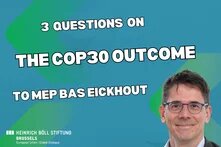Three weeks ago, Brazilians stood by in astonishment as they witnessed yet another example of a climate emergency: the damage caused by the rains in Rio Grande do Sul, Brazil's southernmost state, bordering Uruguay and Argentina. According to the authorities, in a statement released on May 20, 146 deaths and 131 missing people were recorded and more than 81,000 people are still in shelters. 2.3 million people were affected in 463 of the state’s 497 cities. Today, the day this article is being written, the rain has returned heavily to Porto Alegre, the state capital. In addition to these shocking figures, which cannot reflect the immeasurable suffering involved, the tragedy has also fostered another phenomenon of our times that is very devastating: disinformation.

The habitat of disinformation and the content of messages
Disinformation is posted on different platforms simultaneously, like an orchestrated campaign to reach different audiences and reinforce the narrative. Ad posts containing disinformation were found by Netlab, a research lab from Rio de Janeiro Federal University on Meta platforms, and such paid Facebook and Instagram posts gain a boost from algorithms designed to increase their reach.
Disinformation topics have varied among stories of donations, rescues, and the absence of the state. One of the most widespread pieces of disinformation was related to Madonna's concert, which brought together 1.6 million people on Copacabana beach in Rio de Janeiro on 4 May. The message was that the concert had been sponsored by the federal government and that it was not supporting the victims of the tragedy in Rio Grande do Sul. However, there was no federal funding for the concert. Another amplified message was that Lula and first lady Janja were at the concert when heavy rains had already hit Rio Grande do Sul.
Then there were reports that trucks carrying donations were being stopped by authorities because they lacked invoices. Artur Lemos, Rio Grande do Sul's chief of staff, had to use social media to debunk this. Religious intolerance was also propagated in the wave of disinformation. The rains were said to have been caused by a divine curse due to a large number of followers of African religions in the state and were therefore a punishment from God.
The flood of disinformation
Data compiled by the Instituto Democracia em Xeque (DX), a partner of the Heinrich Böll Foundation, between 7 and 13 May, showed that the floods in Rio Grande do Sul dominated social media, with 7.7 million posts and 71.1 million engagements. Of these, 4.3 million posts involved disinformation. In addition, 75 percent of this content was attributed to the far right, as shown in a report by Agência Pública. Agência Lupa, one of Brazil's leading fact-checking news organizations and also a partner of the Foundation, received around 300 fact-checking requests every day on its WhatsApp channel, a volume comparable to the election period.
Disinformation circulating during a climate emergency confuses the population, jeopardizes the distribution of donations, and undermines the credibility of institutions working on the ground. The public authorities' attention needs to be 100% on responding to the crisis: organizing rescues, setting up shelters, publicizing weather reports, and cooperating with civil society, but many public officials had to divert time and effort to combating disinformation.
The sources of the lies and the reactions
The survey by Netlab has shown who the authors of the tsunami of disinformation during the disaster in Rio Grande do Sul are. They are far-right influencers, websites, and politicians. According to the report, the commotion is being used by these people and media outlets to promote themselves and spread disinformation to discredit the government. Some media outlets spread climate denialism by promoting fundraisers and organizing donations, such as the production company Brasil Paralelo, which promotes conspiratorial narratives on environmental issues and others.
Because of that, the Brazilian government reported the case to the Federal Police, pointing to a list of disinformation stories that could jeopardize aid to the victims. Another reaction was a complaint to the Attorney General's Office by Psol (a left-wing party) against seven far-right MPs for spreading disinformation about the disaster. Six of them belong to the party of former president Jair Bolsonaro.
On the international front, some reactions have been noted. One example comes from the statement published by the Davos Economic Forum in the Global Risks Report 2024, stating that disinformation and false information are the biggest short-term risks for the world. In the same vein, the federal Secretariat for Communication (SECOM), as part of the G20 Digital Economy Working Group, organized the G20 side event ‘Information Integrity: combating disinformation, hate speech and threats to democracy on 1 May. João Guilherme Bastos dos Santos, director of DX, one of the speakers, said that it is necessary to go beyond simply denying what is circulating on the internet; it is necessary to understand how the message is circulating in the cultural field of each territory. Bastos was referring to strategies to combat disinformation on the impacts of climate change.
The need for regulation
We need to react to disinformation and there are already many ways to do this: recognize the problem; prevent it, with digital literacy; mitigate it, by denying it; and encourage research on the subject, as well as regulate it and hold it accountable. As Agência Publica founder Natalia Viana said: ‘Predicting and mitigating disinformation is now part of managing public affairs, after all, digital lies are here to stay.’ In the same vein, the organization Mentira Não tem Preço announced: ‘The waters are receding, but disinformation is not going away any time soon.’
In the field of regulation, Bill 2630 has been under discussion since 2020. It has been four years in the making, with big techs opposing regulation of the sector, seeking to maintain a highly concentrated digital environment with little transparency. In addition, the business model of these platforms favors the circulation of disinformation. They want people to stay logged in for as long as possible and the algorithms understand that news that strongly stirs emotions, creating indignation or commotion, engages more. Disinformation takes advantage of this and generates profits for many who promote it.
The data on disinformation that appears on platforms in the form of ads is evidence of the monetary gains involved. A regulated online environment could reduce the financial incentive for such activity. But what we have for now is an agreement between the government and the relevant platforms, signed on 20 May. TikTok, Meta, Kwai, LinkedIn, Google, Kuaishou Technology, Spotify, and a representative from X (formerly Twitter) committed to the promotion of complete, reliable, high-quality information on the situation in Rio Grande do Sul, within the terms of use of the platforms. As these platforms should already be respecting their own terms of use, will this protocol be sufficient to engage them?
From the statement made by the Minister for Indigenous Peoples, it seems not. During the panel on promoting the integrity of information as fundamental to tackling the climate crisis, at the G20 Platforms Digital Economy WG side event, Minister Sonia Guajajara pointed out that for indigenous peoples, a lie or hate speech is a matter of life and death. The emergency is clear and we need to listen to indigenous peoples once and for all.
The views and opinions in this article do not necessarily reflect those of the Heinrich-Böll-Stiftung European Union.


